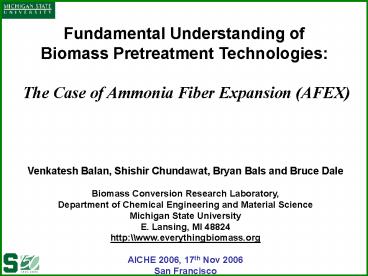Fundamental Understanding of - PowerPoint PPT Presentation
1 / 20
Title: Fundamental Understanding of
1
Fundamental Understanding of Biomass
Pretreatment Technologies The Case of Ammonia
Fiber Expansion (AFEX)
Venkatesh Balan, Shishir Chundawat, Bryan Bals
and Bruce Dale Biomass Conversion Research
Laboratory, Department of Chemical Engineering
and Material Science Michigan State University E.
Lansing, MI 48824 http\\www.everythingbiomass.org
AICHE 2006, 17th Nov 2006 San Francisco
2
A. AFEX Pretreatment Process
Expansion
B. Changes in the biomass after pretreatment
Mosier et al., Bioresour. Technol. 2005
3
AFEX Treated
Untreated
CS- corn stover
Fed-batch SSF on CS after 168 hrs
Teymouri et al., Applied Biochem. Biotechnol.,
2004
4
Understanding the AFEX Process
- What kind of compounds are released during AFEX
process and do they inhibit enzymes and microbes? - Techniques used
- SEM (Scanning Electron Microscope)
- LSCM (Laser Scanning Confocal Microscope) using
Safranin Fluorescent dye - ESCA (Electron Spectroscopy for Chemical
Analysis) - Water Washing to remove degradation compounds
- Phenolic Estimation (Prussian Blue Method)
- LC-MS/UV analysis of wash stream
- Enzymatic Hydrolysis (cellulase,
beta-glucosidase)
5
Schematic view of a woody plant cell wall at
four different magnifications
(Drawn by G. Tambour, Forstliche, Fakultat,
Gottingen)
6
LSCM Corn Cob Fiber Cell Cross Section
50 mms
50 mms
Untreated
AFEX treated
Secondary Cell Walls rich in lignin
Safranin dye binds to lignin-like compounds
smeared on the surface
7
Corn Cob Granule SEM Imaging
Untreated 100x
AFEX treated 100x
8
ESCA Surface Characterization
9
Washing Protocol
- UCS Untreated Corn Stover
- ACS AFEX Corn Stover
AFEX and untreated Wash streams
Chundawat et. al., Biotech. Bioeng., 2006 (in
press)
10
Prussian Blue Analysis
Bagasse
SG Switch grass WS Wheat Straw RS
Rice Straw CS Corn stover
11
Degradation Products During Dilute Acid
Pretreatment
Palmqvist et. al., Bioresource Technol. 2000
12
Comparing Degradation Products AFEX vs Dilute
Acid Pretreatment
Unknown compounds co-elute along with lactic
acid
Collaborative work with Dr. Kevin at Baylor
Institute of Technology Dilute acid hydrolysate
data from Chen et al., 2006
13
Inhibition of Enzymes at varying Wash Stream
Concentrations
Enzymes 15 FPU Cellulase (Genencor), 64 p-NPGU
b-Glucosidase (Novozyme) Biomass Substrate 1
avicel loading Wash Streams (WS) AFEX
Untreated (Unt) Corn Stover
168h
48h
24h
(A)
(B)
(A)
(B)
- Low Concentration of Wash Stream (equivalent to
1 glucan loading) - High Concentration of Wash Stream (equivalent to
10 glucan loading)
14
Inhibitory effect of some AFEX degradation
products
72 hrs hydrolysis data 15 FPU of
Cellulase Low Conc (A) Medium
Conc (B) High Conc (C)
A
B
C
LA Lactic acid AA Acetic acid CA Cafeic acid V
Vanillin BA Benzoic acid FA Ferulic acid BD
4-hydroxybenzaldehyde CouA p-coumaric
acid Combined mixture of all
- Low Concentration of Wash Stream (equiv to 1
glucan loading) - Medium Concentration of Wash Stream component
(equiv to 3.3 glucan loading) - High Concentration of Wash Stream (equiv to 10
glucan loading)
15
Lignin-Hemicellulose Complex
Source http//141.150.157.1178080/prokPUB/chapht
m/297/03_00.htm
16
Oligosaccharide and monosaccharide componentsin
AFEX wash stream
- What do we know about AFEX wash stream
Oligosaccharides? - High degree of polymerization (gt 10), similar
for AFEX treated grasses (Corn stover, rice
straw, bagasse, switchgrass) - Arabinoxylan based oligosaccharides, for corn
stover atleast - Need to study if AFEX is cleaving very specific
LCC (lignin-hemicellulose complex) bonds
17
Summary
- AFEX is a novel alkali based pretreatment,
however, a - fundamental understanding of the process is
still lacking - ESCA, LSCM, SEM indicate lignin-hemicellulose
degradation, - solubilization and deposition on biomass
surface - Liquid ammonia also cleaves hemicellulose to
- oligosaccharides, at specific cleavage sites
possibly - Degradation products released during AFEX
process Short - chain Organic Acids (acetic, lactic),
Phenolic and Aromatic - acids inhibit enzymes to a certain degree.
- Future Studies Wash Stream analysis for other
biomasses, - Effect of degradation components on microbes
18
Biomass Conversion Research Lab at Michigan
State University
Left to Right (Back) Shishir, Derek, Bryan,
Ming Left to Right (Front) Elizabeth, Dr. Dale,
Dr. Ven, Holly, Ben
19
Acknowledgements
- CAFI Team (for valuable suggestions)
- Dr Shirley Owens, MSU (LSCM)
- Dr Per Askeland, MSU (ESCA)
- Dr Kevin Chambliss Group, Baylor University
(LC-UV/MS) - Genencor International (for Enzymes)
20
References
- Effect of particle size based separation of
milled corn stover on AFEX pretreatment and
enzymatic digestibility (p n/a) Shishir P. S.
Chundawat, Balan Venkatesh, Bruce E. Dale (In
Press, J Biotech Bioeng) - Understanding AFEX I Inhibitory Effect of
Ammonia Fiber Explosion (AFEX) Pretreatment of
Corn Stover on Enzymatic Hydrolysis. Shishir PS
Chundawat, Balan Venkatesh, Bryan D Bals,
Shou-Feng Chen, Christopher Becker, C Kevin
Chambliss, G Peter van Walsum, Bruce E Dale
(Manuscript Submitted) - High-performance liquid chromatography method for
simultaneous determination of aliphatic acid,
aromatic acid and neutral degradation products in
biomass pretreatment hydrolysates. Chen SF,
Mowery RA, Castleberry VA, van Walsum GP,
Chambliss CK. 2006. J Chromatogr A. 110454-61
21
(No Transcript)

















![[PDF] Mosby's Biomedical Science Series: Understanding Immunology Full PowerPoint PPT Presentation](https://s3.amazonaws.com/images.powershow.com/10081942.th0.jpg?_=20240719047)













